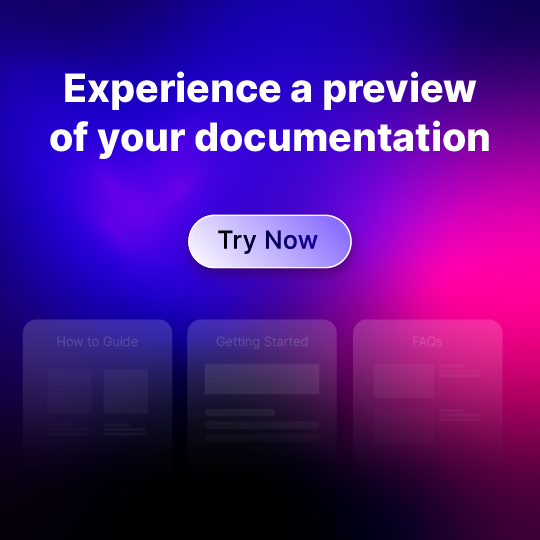First impressions are everything. Often, the first interaction between your product and a user is through a “Getting Started Guide”, which is essential to their overall experience and long-term satisfaction.
Imagine opening a device without a manual—of course, it would be frustrating. Similarly, a poorly written guide can leave users feeling lost. At the same time, a well-written one, on the other hand, helps users navigate installation, learn more about essential features, or even get started instantly.
86% of clients will likely remain loyal to organizations with proper onboarding processes. This way, you are ensuring that your customers will come back to you more often and for more extended periods if you start by putting the needs of your future users first
This article will detail how to create an effective getting-started guide that will result in memorable first impressions.
What is a Getting Started Guide?
A Getting Started Guide is a comprehensible document that allows users to start working successfully with the product or service. It presents basic setup information in easy step-by-step instructions, troubleshooting tips, and configuration of primary functions.
It shows them how to begin getting value from the product quickly. This initial support goes a long way toward making positive first impressions, reducing frustration, and promoting higher engagement.
The best practice here is to write a concise Getting Started Guide that reduces confusion among customers and enables them to concentrate on what matters most – their own needs concerning this specific software solution.
Why You Should Have a Getting Started Guide?
Guides Users Through the Initial Setup
Every product has unique features that can be daunting if one is unsure of what to look for upon using the tool for the first time. Users should not feel frustrated that they don’t understand how the program is set up; a good guide instructs them in simple steps. This immediate gratification helps distinguish between those who will remain loyal and those who will quit this product forever.
Reduces Support Needs
Users like to self-serve, especially when clear instructions are available. If users can navigate your product effortlessly, they won’t need to ask basic questions, reducing the strain on customer support. 70% of users find the self-service convenient and avoid approaching the support service. A well-written Getting Started Guide is your number one ally when it comes to first-level support – because the guide enables users to resolve issues by themselves and leaves the more challenging cases for your support team.
Encourages Users to Explore Features
A “Getting Started” guide focuses on explaining some basic techniques or actions and tries to guide users to other subsequent higher-level features. When you describe the core functions at the beginning of the interaction, you make the clients interested and active in using your product’s opportunities more actively. This leads to increased client satisfaction and chances of converting them into brand loyalists. The more they learn, the greater the chances they can gain value from your solution.
Creates a Shallow Learning Curve for New Users
A high learning curve disengages users from fully engaging with your product. Getting Started is a guide, and it should be designed so that learning occurs step by step with confidence. This is good for users as they are not suddenly faced with a steep learning curve, hence keeping them around and reducing churn.
Getting Started Guide vs. Quick Start Guide
A ‘Quick Start Guide’ offers users the basic tips they may need to start immediately.
“Getting Started” guides and “Quick Start” are meant to assist the users, but their goals and functions differ.
Focus
- Getting Started Guide: A beginner’s guide that entails the basic features of some of the more complex aspects.
- Quick Start Guide: Immediate action, focusing on essential steps to get started quickly.
Content Depth
- Getting Started Guide: Explained clearly and also in detail and many examples are given.
- Quick Start Guide: Condensed text of oversights to focus on elementary purposes.
Length
- Getting Started Guide: Longer, more frequently in the form of manuals, ebooks, or article series.
- Quick Start Guide: Shorter a one-page document, short video, or leaflet.
Purpose
- Getting Started Guide: Ideal for users wanting to explore all product features.
- Quick Start Guide: Perfect for users who need fast, actionable steps
Of course, getting started guides and quick start guides are essential for onboarding users.
Which matters more: The Getting Started Guide or the Quick Start Guide?
The right answer? Both.
Hence, if a user depends on a quick start guide, they will not grasp the other features of your product. Similarly, a daunting getting started guide might result when the user wants straightforward steps that will help him or her start.
Nonetheless, getting started guides and quick start guides are interdependent. They should only be provided to meet different user needs and preferences. This is important in ensuring that, in either case, someone wants to delve deep or get initial steps in the shortest time possible.
Interested in Document360 Knowledge Base? Schedule a demo with one of our experts
Book A Demo
What to Include in a Getting Started Guide?
Creating a compelling Getting Started Guide helps onboard new users effectively. Here’s how you can structure your guide for it to be informative yet interesting:
Brief Overview and Purpose
When designing this kind of guide, start by summarizing what the guide is about in a few words. This section should describe what the user will accomplish when completing the instructions, and a sneak preview should be offered. Make your overview and tell them what they can do with the Getting Started Guide once they finish it. Reduce this to one short paragraph or two sentences and in bullets that can represent steps.

Source: Document360 Docs
Quick Tutorial or Instructions for Initial Use
A Quick Tutorial or Instructions for Initial Use must be part of a Get-Started Guide because it gives the user a directory to immediately use your product. For instance, the following is a step-by-step guide on how to sign up for Document360.

Source: Document360 Docs
Customers appreciate it when you offer them quick wins like a demo or clear instructions for use – they start seeing the benefits immediately. A well-executed tutorial allows customers to get quick value out of the system. Thus, it forms the basis of an enjoyable experience and long-term satisfaction.
Include Visual Aids
Use images, videos, or GIFs that illustrate the steps. This minimizes confusion and mistakes.
Screenshots also assist the users in the registration and setup process.

A good Getting Started Guide should have some visual aids. And ensure that:
- Pictures, drawings, or screenshots must be clear.
- Visuals must also have a connection to the text being used.
- Lay it simply, and do not bring something else to the mix
- Lastly, all visuals must be identified to ensure smooth flow when users proceed from one step to the other.
Below are some examples of quick tutorials for each feature:

Highlight Key Features for Further Exploration
A good Getting Started Guide should identify some unique features users want to explore.
- First, focus on the features that generate the most value and are crucial to the product.
- Keep it fundamental while at the same time informative.
- Use screenshots or videos so those who visit will instantly know what these aspects look like.
- Show real-world applications by giving examples or using cases.
Share Links to Documentation and Support Resources

This way, users can solve more advanced queries than with the basic setup and features. This ensures that users know where to get assistance if necessary, therefore smoothening onboarding.
Document360 contains links to documentation, additional articles, tutorials, and other resources on handling customer support.

Also Read: Quick Start Guide: What is it & How do you Create one
Elements of a Good Getting Started Guide
Here are the five core elements of a good getting-started guide:
Simple and Jargon-Free Language
Jargon complicates—clear language makes it easy for them to manage your product. Getting Started guides are types of user manuals with instructions for performing several types of operations that require little effort.
To implement simple and jargon-free language:
- Explain any necessary jargon: For Instance, “An example of a knowledge base is defined as an online database of information. ”
- To check for readability, use either Hemingway or Grammarly.
- Finally, less experienced readers should be asked to express their opinions, as they can sometimes be confused by the issue at hand.
Easy-to-Follow Instructions
Clear instructions don’t only tell what actions to perform; they describe how procedures are done.
Think about it: who wants to speculate about the next move, when, or if the signals are fuzzy? Not your users.
Include a flow, preferably a numerical sequence of a plan that is easily understandable.
Most importantly, each step should contain only action; if there are more, mistakes will occur.
Always remember that users are not only reading texts but interacting with your product right now.
Finally, after creating a guide, offer it to some real users, take the information they share with you seriously, and fine-tune it if necessary.
Clear instructions are not a luxury or a bonus but a necessity in any given guide for getting.
Visual Aids: Diagrams and Screenshots
Diagrams and screenshots make it easy for a reader to follow complicated features. By including screenshots pointing to specific tools or options, users know where to go. These aids enhance understanding and learning speed, making the guide more appealing to the user. Without them, even the most basic instructions given by the creators can lead to confusion among the users.


Source: Document360 Docs
They can also represent processes or flow charts and might provide users with a preview of what they are up for or need to pay attention to without going into too much detail.
Taking User Knowledge into Consideration
It is clear that one user is not like another – there are novices and professionals.
Knowledge of this is helpful for better targeting content for beginners and experts in parallel. It would be quite remiss to assume that user knowledge is only necessary for the sake of clarity; it is about respecting the User. It ensures that both the new and the experienced users are assured that they are getting some sort of help or direction.
This attentiveness improves a specific user’s experience and decreases the time required to complete a product’s learning curve, which makes onboarding more effective.
For instance, Here in the Documentation explaining the feature and use case will improve the product learning curve
For novices, it starts with the basics: What is SSO?

Source: Document360 Docs
Regular Revisions
As products evolve and features change, outdated information can lead to user frustration.
It must be pointed out that guides must remain accurate, timely, and relevant to the current version of your product—not just occasionally has to be pointed out that guides have to remain accurate, timely, and relevant to the current version of your product – not just occasionally, but permanently.
So, how do you ensure your guide remains intuitive and relevant?
- Establish a revision schedule
- Track product updates
- Analyze user data
- Conduct periodic testing
- Maintain a version history
- Continually reviewing industry best practices helps keep the guide current.
They refine the user experience by concurrently suppressing the number of calls for assistance during the brief and painless onboarding process.

For instance, Document360 always revises its software, and based on new features and users’ feedback, the tool has a “What’s New” section.

Source: Document360 Docs
Wrapping Up
We’ve gone through a lot in this article!
You’ve learned what a Getting Started guide is, why it matters, how to put it together, and the top tips for writing one. Getting Started guide is all about giving your users the power to use your product well. Want to make your own Getting Started guide? Sign up on today and begin creating guides that pull users in and speed up their success with your product!





 –
– 

